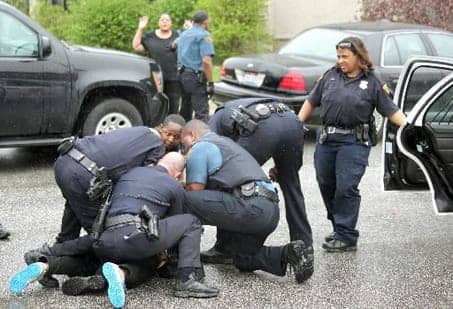Students’ rights must be respected while ensuring school safety
by Will Matthews

The report provides specific policy recommendations for the use of police in schools so that police officers deployed to schools are given the tools necessary for maintaining safe school environments while respecting the rights of students and the overall school climate.
“It is essential that the work of police on school campuses be guided by formal standards and policies,” said Catherine Y. Kim, staff attorney with the ACLU Racial Justice Program and co-author of the study. “As the number of police officers on school campuses across the country continues to grow, there is a real risk that without concrete guidelines, student behavior will be unnecessarily criminalized and school environments will become increasingly toxic.”
The study – or white paper – identifies six key policy guidelines that should govern the use of police in schools, including distinguishing between disciplinary misconduct to be handled by school officials and criminal offenses to be handled by law enforcement, and the promotion of non-punitive approaches to student behavior.
According to the ACLU’s white paper, the number of children arrested or referred to court for minor disciplinary infractions is on the rise. In South Carolina, for example, the single most common offense resulting in a juvenile court referral during the 2007-08 school year was “disturbing schools.”
During the same year in Florida, 15 percent of all delinquency referrals stemmed from school-related conduct, with 40 percent involving “disorderly conduct” or “misdemeanor assault and battery.”
Last year in Birmingham, Alabama, 19 percent of juvenile arrests resulting in court referral were for school misconduct and, among those, 33 percent were for fights, 29 percent were for disorderly conduct and 21 percent were for trespassing or harassment.
Studies have shown that improper school-based arrests dramatically increase the likelihood of students dropping out of school and reduce students’ chances of succeeding academically.
Children of color and students with disabilities are disproportionately represented among those students arrested or referred to court, exacerbating the disturbing national trend known as the “school-to-prison-pipeline,” wherein children are over-aggressively pushed out of public schools and into the juvenile and criminal justice systems.
“There are serious problems with relying too heavily on police to maintain order and to provide discipline without ensuring that police understand exactly how they fit within the overarching educational framework of schools,” said I. India Geronimo, Marvin M. Karpatkin Fellow with the ACLU Racial Justice Program and co-author of the report.
“When arresting kids for misbehaving becomes the primary mode of discipline, some of our most vulnerable populations end up being unnecessarily criminalized at very young ages before alternatives that could lead to academic success are exhausted.”
The white paper also advocates that any governing policy ensure that police on school campuses be given minimum training requirements, that the role of police within the context of the educational mission of the school is explicitly defined, that police operate in a manner that is transparent and accountable and that police respect the rights of children in school.
Although there are no available figures documenting the current number of police officers patrolling school campuses in the U.S., it is clear that schools across the country have begun to deploy police on school grounds in growing numbers. In 2004, for example, studies show that 60 percent of high school teachers reported armed police officers stationed at their schools, and in 2005 nearly 70 percent of public school students between the ages of 12 and 18 said police officers or security guards patrol their hallways.
Frequently referred to as “School Resource Officers” or SROs, the police on school campuses are often sworn police officers employed by local police departments and assigned to patrol public school hallways full time.
A copy of the ACLU’s white paper is available online at www.aclu.org/racialjustice/edu/40816pub20090824.html. Additional information about the ACLU Racial Justice Program is available online at www.aclu.org/racialjustice. Additional information about the school-to-prison-pipeline is available online at www.aclu.org/stpp.
Contact the American Civil Liberties Union at 125 Broad St., 18th Floor, New York, NY 10004-2400, or www.aclu.org.





